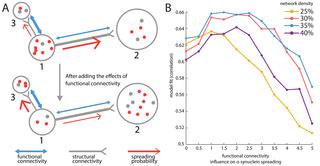当前位置:
X-MOL 学术
›
PLOS Biol.
›
论文详情
Our official English website, www.x-mol.net, welcomes your feedback! (Note: you will need to create a separate account there.)
Local vulnerability and global connectivity jointly shape neurodegenerative disease propagation.
PLOS Biology ( IF 9.8 ) Pub Date : 2019-11-21 , DOI: 10.1371/journal.pbio.3000495 Ying-Qiu Zheng 1 , Yu Zhang 1, 2 , Yvonne Yau 1 , Yashar Zeighami 1 , Kevin Larcher 1 , Bratislav Misic 1 , Alain Dagher 1
PLOS Biology ( IF 9.8 ) Pub Date : 2019-11-21 , DOI: 10.1371/journal.pbio.3000495 Ying-Qiu Zheng 1 , Yu Zhang 1, 2 , Yvonne Yau 1 , Yashar Zeighami 1 , Kevin Larcher 1 , Bratislav Misic 1 , Alain Dagher 1
Affiliation

|
It is becoming increasingly clear that brain network organization shapes the course and expression of neurodegenerative diseases. Parkinson disease (PD) is marked by progressive spread of atrophy from the midbrain to subcortical structures and, eventually, to the cerebral cortex. Recent discoveries suggest that the neurodegenerative process involves the misfolding and prion-like propagation of endogenous α-synuclein via axonal projections. However, the mechanisms that translate local "synucleinopathy" to large-scale network dysfunction and atrophy remain unknown. Here, we use an agent-based epidemic spreading model to integrate structural connectivity, functional connectivity, and gene expression and to predict sequential volume loss due to neurodegeneration. The dynamic model replicates the spatial and temporal patterning of empirical atrophy in PD and implicates the substantia nigra as the disease epicenter. We reveal a significant role for both connectome topology and geometry in shaping the distribution of atrophy. The model also demonstrates that SNCA and GBA transcription influence α-synuclein concentration and local regional vulnerability. Functional coactivation further amplifies the course set by connectome architecture and gene expression. Altogether, these results support the theory that the progression of PD is a multifactorial process that depends on both cell-to-cell spreading of misfolded proteins and regional vulnerability.
中文翻译:

局部脆弱性和全球连通性共同决定了神经退行性疾病的传播。
越来越清楚的是,大脑网络组织决定了神经退行性疾病的病程和表达。帕金森病(PD)的特征是萎缩从中脑逐渐扩散到皮层下结构,并最终扩散到大脑皮层。最近的发现表明神经退行性过程涉及通过轴突投射的内源性α-突触核蛋白的错误折叠和病毒样繁殖。但是,将局部“突触核蛋白病”转化为大规模网络功能障碍和萎缩的机制仍然未知。在这里,我们使用基于代理的流行病传播模型来整合结构连接性,功能连接性和基因表达,并预测由于神经退行性变而导致的连续体积损失。动态模型复制了PD中经验性萎缩的时空分布,并暗示黑质为疾病的中心。我们揭示了连接套拓扑和几何形状在塑造萎缩分布中的重要作用。该模型还证明SNCA和GBA转录会影响α-突触核蛋白浓度和局部区域脆弱性。功能性共激活进一步通过连接基因组结构和基因表达放大了这一过程。总而言之,这些结果支持了PD的进展是一个多因素过程的理论,该过程取决于错误折叠的蛋白质在细胞间的扩散和区域易损性。我们揭示了连接套拓扑和几何形状在塑造萎缩分布中的重要作用。该模型还证明SNCA和GBA转录会影响α-突触核蛋白浓度和局部区域脆弱性。功能性共激活进一步通过连接基因组结构和基因表达放大了这一过程。总而言之,这些结果支持了PD的进展是一个多因素过程的理论,该过程取决于错误折叠的蛋白质在细胞间的扩散和区域易损性。我们揭示了连接套拓扑和几何形状在塑造萎缩分布中的重要作用。该模型还证明SNCA和GBA转录会影响α-突触核蛋白浓度和局部区域脆弱性。功能性共激活进一步通过连接基因组结构和基因表达放大了这一过程。总而言之,这些结果支持了PD的进展是一个多因素过程的理论,该过程取决于错误折叠的蛋白质在细胞间的扩散和区域易损性。
更新日期:2019-12-03
中文翻译:

局部脆弱性和全球连通性共同决定了神经退行性疾病的传播。
越来越清楚的是,大脑网络组织决定了神经退行性疾病的病程和表达。帕金森病(PD)的特征是萎缩从中脑逐渐扩散到皮层下结构,并最终扩散到大脑皮层。最近的发现表明神经退行性过程涉及通过轴突投射的内源性α-突触核蛋白的错误折叠和病毒样繁殖。但是,将局部“突触核蛋白病”转化为大规模网络功能障碍和萎缩的机制仍然未知。在这里,我们使用基于代理的流行病传播模型来整合结构连接性,功能连接性和基因表达,并预测由于神经退行性变而导致的连续体积损失。动态模型复制了PD中经验性萎缩的时空分布,并暗示黑质为疾病的中心。我们揭示了连接套拓扑和几何形状在塑造萎缩分布中的重要作用。该模型还证明SNCA和GBA转录会影响α-突触核蛋白浓度和局部区域脆弱性。功能性共激活进一步通过连接基因组结构和基因表达放大了这一过程。总而言之,这些结果支持了PD的进展是一个多因素过程的理论,该过程取决于错误折叠的蛋白质在细胞间的扩散和区域易损性。我们揭示了连接套拓扑和几何形状在塑造萎缩分布中的重要作用。该模型还证明SNCA和GBA转录会影响α-突触核蛋白浓度和局部区域脆弱性。功能性共激活进一步通过连接基因组结构和基因表达放大了这一过程。总而言之,这些结果支持了PD的进展是一个多因素过程的理论,该过程取决于错误折叠的蛋白质在细胞间的扩散和区域易损性。我们揭示了连接套拓扑和几何形状在塑造萎缩分布中的重要作用。该模型还证明SNCA和GBA转录会影响α-突触核蛋白浓度和局部区域脆弱性。功能性共激活进一步通过连接基因组结构和基因表达放大了这一过程。总而言之,这些结果支持了PD的进展是一个多因素过程的理论,该过程取决于错误折叠的蛋白质在细胞间的扩散和区域易损性。



























 京公网安备 11010802027423号
京公网安备 11010802027423号